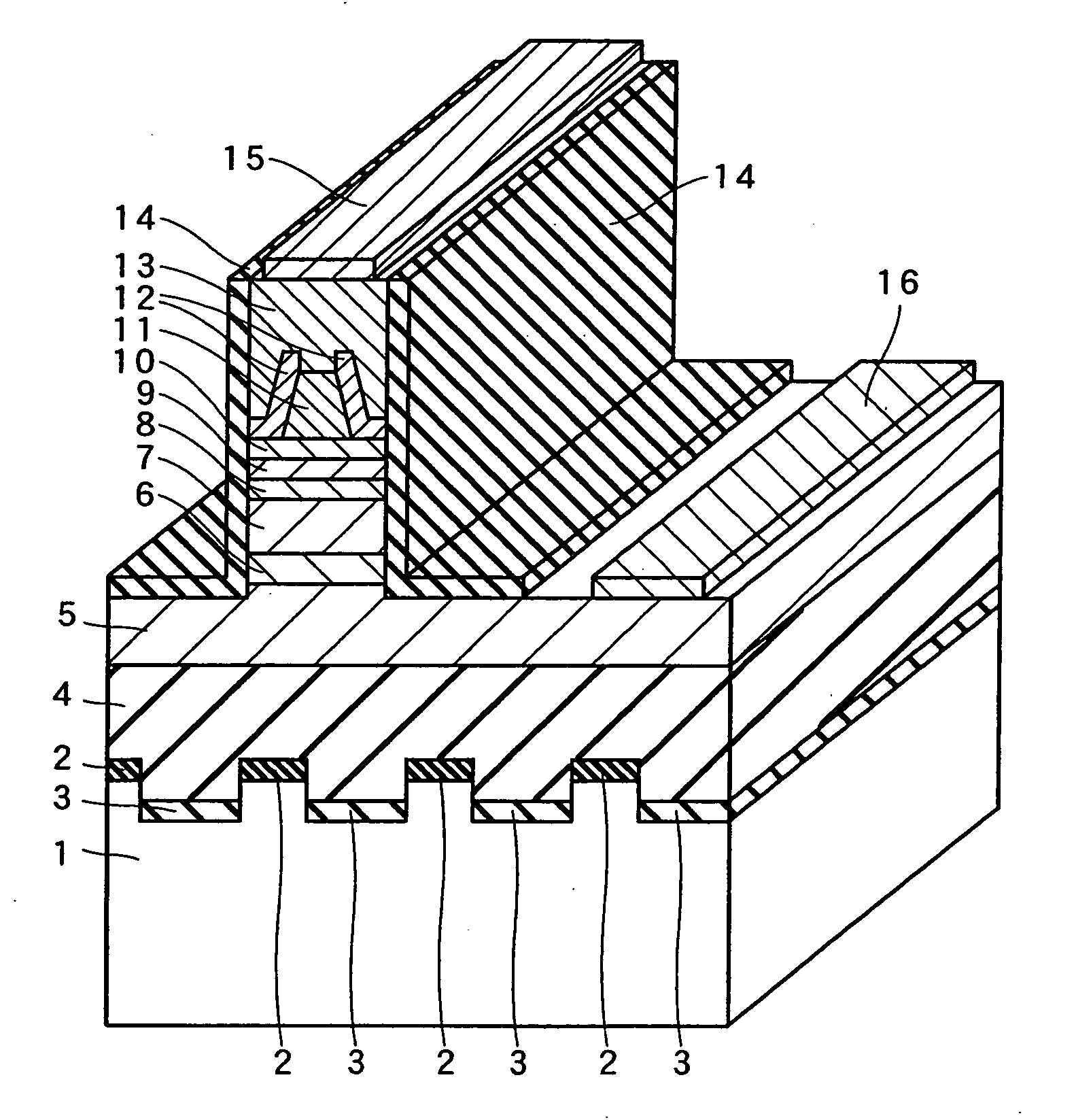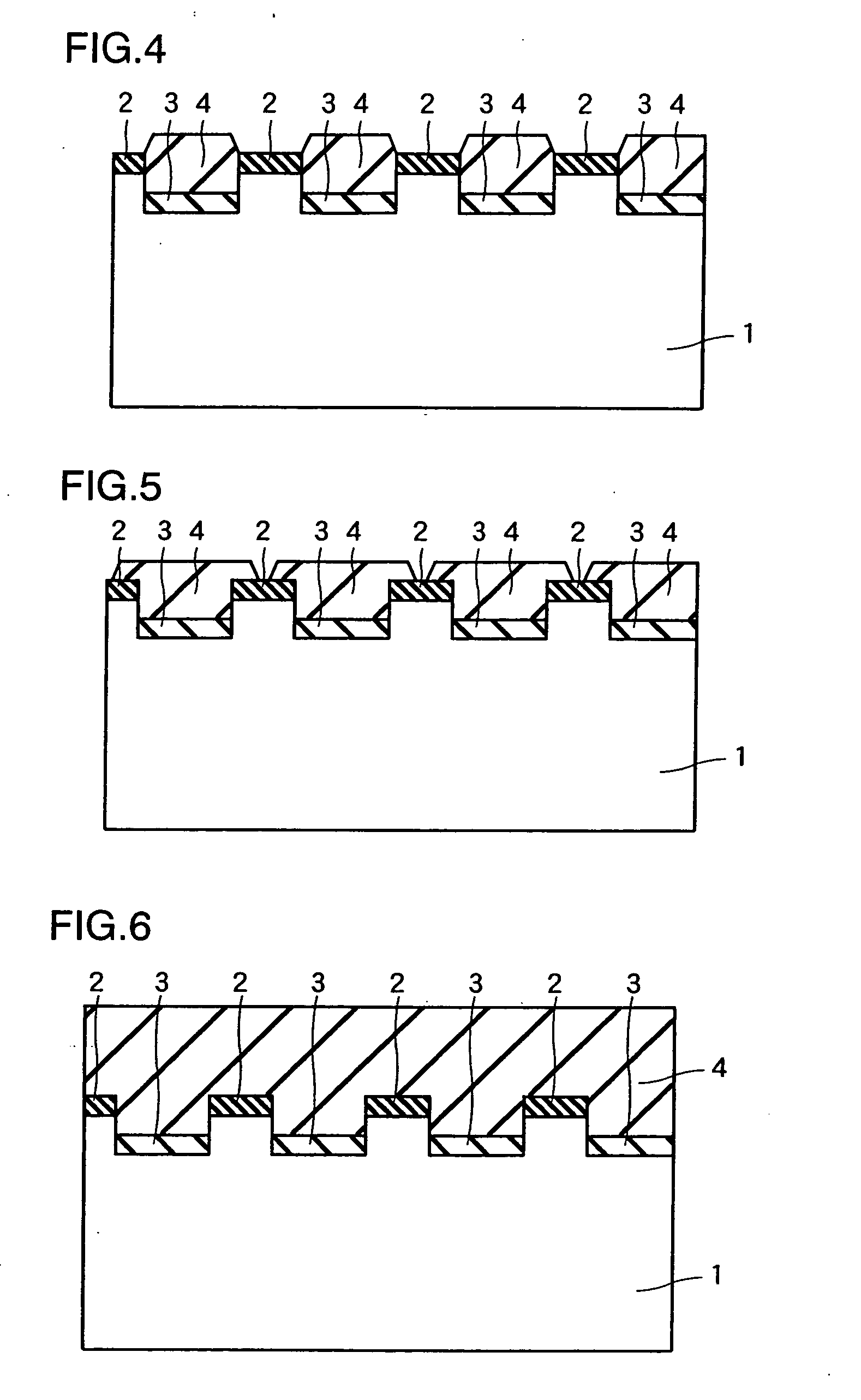Nitride-based semiconductor element and method of forming nitride-based semiconductor
a technology of nitride-based semiconductor and semiconductor elements, which is applied in the direction of semiconductor lasers, semiconductor laser structural details, lasers, etc., can solve the disadvantageous increase of the etching time for bringing the substrate b>101/b> into the ridged shape, deterioration of the element characteristics of the semiconductor element, etc., and achieve excellent element characteristics and superior mass productivity.
- Summary
- Abstract
- Description
- Claims
- Application Information
AI Technical Summary
Benefits of technology
Problems solved by technology
Method used
Image
Examples
first embodiment
[0049] A method of forming a nitride-based semiconductor according to a first embodiment of the present invention is described with reference to FIGS. 1 to 6.
[0050] First, striped mask layers 2 of SiO2 having a thickness of about 0.5 μm are formed on a sapphire (0001) plane substrate 1 (hereinafter referred to as “sapphire substrate 1”), as shown in FIG. 1. The stripe patterns of the mask layers 2 are formed in a cycle of about 7 μm so that the width of the mask layers 2 is about 5 μm and the interval between each adjacent pair of mask layers 2 (the width of mask openings) is about 2 μm. The striped mask layers 2 are formed in parallel to the [1-100] direction of the sapphire substrate 1. The sapphire substrate 1 is an example of the “substrate” according to the present invention.
[0051] The mask layers 2 are employed as masks for etching the surface of the sapphire substrate 1 by a thickness of about 1 μm through RIE (reactive ion etching) or the like. Thus, the surface of the sap...
second embodiment
[0066] Referring to FIGS. 8 to 13, an n-type Si (111) plane substrate 21 (hereinafter referred to as “Si substrate 21”) having conductivity is employed in a second embodiment of the present invention in place of the insulating sapphire substrate 1 in the first embodiment. A method of forming a nitride-based semiconductor according to the second embodiment is now described with reference to FIGS. 8 to 13.
[0067] According to the second embodiment, striped mask layers 22 of SiO2 having a thickness of about 0.5 μm are formed on the n-type Si substrate 21, as shown in FIG. 8. The stripe patterns of the mask layers 22 are formed in a cycle of about 7 μm, so that the mask layers 22 are about 5 μm in width and the interval between each adjacent pair of mask layers 22 (the width of mask openings) is about 2 μm. The striped mask layers 22 are formed in parallel to the [1-10] direction of the Si substrate 21. The Si substrate 21 is an example of the “substrate” according to the present invent...
third embodiment
[0084] Referring to FIGS. 15 to 20, epitaxial lateral overgrowth is performed through an underlayer 43 comprising a surface having projection portions formed on a sapphire (0001) plane substrate 41 (hereinafter referred to as “sapphire substrate 41”) in a third embodiment of the present invention. A method of forming a nitride semiconductor according to the third embodiment is now described in detail with reference to FIGS. 15 to 20.
[0085] First, low-temperature buffer layers 42 of AlGaN having a thickness of about 15 nm and the underlayer 43 of undoped GaN having a thickness of about 2 μm are formed on the sapphire substrate 41 by a crystal growth method such as MOVPE, as shown in FIG. 15. The sapphire substrate 41 is an example of the “substrate” according to the present invention. The low-temperature buffer layers 42 are examples of the “buffer layer” according to the present invention.
[0086] Striped mask layers 44 of SiO2 having a thickness of about 0.5 μm are formed on the un...
PUM
 Login to View More
Login to View More Abstract
Description
Claims
Application Information
 Login to View More
Login to View More - R&D
- Intellectual Property
- Life Sciences
- Materials
- Tech Scout
- Unparalleled Data Quality
- Higher Quality Content
- 60% Fewer Hallucinations
Browse by: Latest US Patents, China's latest patents, Technical Efficacy Thesaurus, Application Domain, Technology Topic, Popular Technical Reports.
© 2025 PatSnap. All rights reserved.Legal|Privacy policy|Modern Slavery Act Transparency Statement|Sitemap|About US| Contact US: help@patsnap.com



